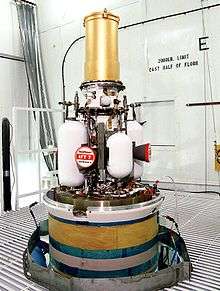Exoatmospheric Kill Vehicle
The Exoatmospheric Kill Vehicle (EKV) is the Raytheon-manufactured interceptor component with subcontractor Aerojet of the U.S. Ground-Based Midcourse Defense (GMD), part of the larger National Missile Defense system.

The EKV is boosted to an intercept trajectory by a boost vehicle (missile), where it separates from the boost vehicle and autonomously collides with an incoming warhead.
The EKV is launched by the Ground-Based Interceptor (GBI) missile, the launch vehicle of the GMD system. The EKV's own rockets and fuel are for corrections in the trajectory, not for further acceleration.
The successor to the EKV, known as the Redesigned Kill Vehicle (RKV), was scheduled to debut in 2025[1]. The RKV program, headed by Boeing and lead subcontractor Raytheon, was canceled by the Department of Defense on August 21, 2019. Earlier in the year, the Pentagon had issued a stop work order on the project following a design review deferment in December 2018 due to the failure of critical components meeting technical specification.[2]
Characteristics
- Weight: approx. 140 lb (64 kg)
- Length: 55 in (4 ft. 7 in.) (1.4 m)
- Diameter: 24 in (2 ft.) (0.6 m)
- Speed of projectile: roughly 10 km/s (22,000 mph)[3]
See also
References
- Wichner, David. "ICBM target downed in key test of missile defense, Raytheon warhead". Arizona Daily Star. Retrieved 2019-03-26.
- Pietsch, Bryan. "Pentagon ends Boeing 'kill vehicle' contract, cites technical problems". Reuters. Retrieved 2019-08-21.
- "Archived copy" (PDF). Archived from the original (PDF) on December 29, 2009. Retrieved February 27, 2010.CS1 maint: archived copy as title (link)